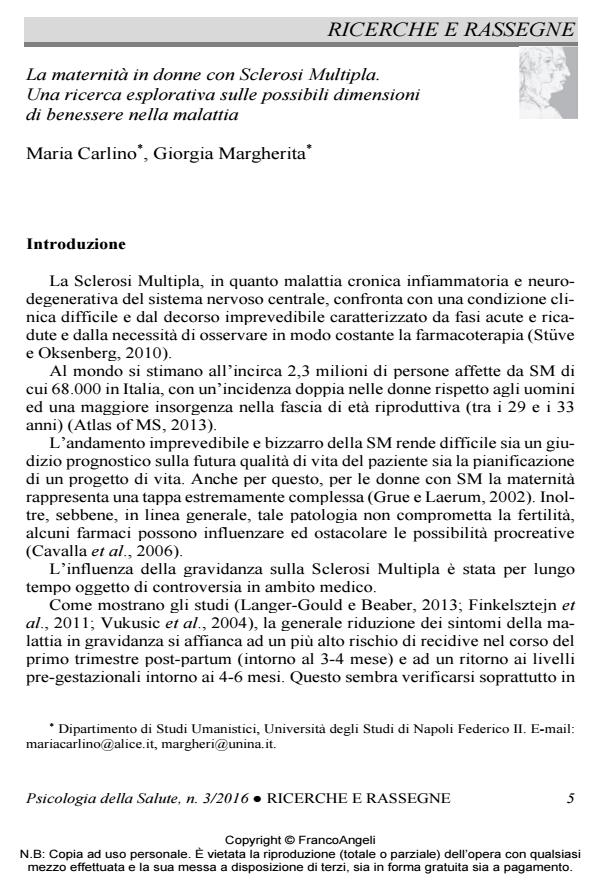Motherhood in women with Multiple Sclerosis. An explorative research about the possible dimensions of well-being even in the illness
Journal title PSICOLOGIA DELLA SALUTE
Author/s Maria Carlino, Giorgia Margherita
Publishing Year 2016 Issue 2016/3
Language Italian Pages 21 P. 5-25 File size 315 KB
DOI 10.3280/PDS2016-003001
DOI is like a bar code for intellectual property: to have more infomation
click here
Below, you can see the article first page
If you want to buy this article in PDF format, you can do it, following the instructions to buy download credits

FrancoAngeli is member of Publishers International Linking Association, Inc (PILA), a not-for-profit association which run the CrossRef service enabling links to and from online scholarly content.
To women with Multiple Sclerosis motherhood is an extremely complicated stage. The aim of this paper is to explore the meanings that motherhood and illness assume for these women starting from the idea that the representational aspects might influence orientation, projects and choices. Methods. 20 women with MS were involved and interviewed by a semi-structured interview. The texts of the interviews were analyzed with a cluster analysis implemented by the software T-Lab (Lancia, 2004). Results. From the cluster analysis four thematic clusters emerged, named: the pain of everyday life, dependence from the medical area, close the circle and family role. These results were interpreted on the factorial axis where they organized three vectors of sense representative of the dynamics: from the concrete field to the abstract one, from the project to the spillover effects, from supporting Service to the family support, which highlight representational space where it is difficult to keep together illness and motherhood. Conclusions. We observed how some dimensions (as being a couple or a diagnosis known from longer time) might represent supporting factors to choose a project of motherhood. Some thoughts about the need to design interventions in to the HealthCare Services, that could integrate psychological aspects in usual therapeutic paths, emerge.
Keywords: Multiple Sclerosis, motherhood, representations
- Teen mothers who are daughters of teen mothers: Psychological intergenerational dimensions of early motherhood Giorgia Margherita, Gina Troisi, Francesca Tessitore, Anna Gargiulo, in Children and Youth Services Review /2017 pp.294
DOI: 10.1016/j.childyouth.2017.10.010 - Illness representation in patients with multiple sclerosis: A preliminary narrative medicine study T Paolucci, M Reho, C Ciacchella, G Veneziani, I Santoro, G Fiorentino, F Galli, C Lai, in Multiple Sclerosis Journal - Experimental, Translational and Clinical 20552173241271755/2024
DOI: 10.1177/20552173241271755 - Female Nigerian asylum seekers in Italy: An exploration of gender identity dimensions through an interpretative phenomenological analysis Francesca Tessitore, Giorgia Margherita, in Health Care for Women International /2021 pp.165
DOI: 10.1080/07399332.2019.1692849 - Underfifty Women and Breast Cancer: Narrative Markers of Meaning-Making in Traumatic Experience Maria Luisa Martino, Daniela Lemmo, Anna Gargiulo, Daniela Barberio, Valentina Abate, Franca Avino, Raffaele Tortoriello, in Frontiers in Psychology 618/2019
DOI: 10.3389/fpsyg.2019.00618 - Italian Validation of the Capacity to Love Inventory: Preliminary Results Giorgia Margherita, Anna Gargiulo, Gina Troisi, Francesca Tessitore, Nestor D. Kapusta, in Frontiers in Psychology 1434/2018
DOI: 10.3389/fpsyg.2018.01434
Maria Carlino, Giorgia Margherita, La maternità in donne con Sclerosi Multipla. Una ricerca esplorativa sulle possibili dimensioni di benessere nella malattia in "PSICOLOGIA DELLA SALUTE" 3/2016, pp 5-25, DOI: 10.3280/PDS2016-003001